*NURSING > EXAM > NURS 250 Care of Patients with Noninfectious upper Respiratory problems | Chapter 29 Care of Patient (All)
NURS 250 Care of Patients with Noninfectious upper Respiratory problems | Chapter 29 Care of Patients with Noninfectious upper Respiratory problems
Document Content and Description Below
NURS 250 Care of Patients with Noninfectious upper Respiratory problems { Chapter 29 } – New England Institute of Technology Chapter 29 Care of Patients with Noninfectious upper Respiratory probl... ems Vocab: • Xerostomia- dry mouth • Leukoplakia- lite patchy lesion • Erythroplakia- red, velvety patches • Upper Airway • nose, sinuses, oropharynx, larynx, and trachea; gas exchange and perfusion=entrance site of air; Larynx and trachea problems=interfere with O2 delivery; Nursing priority- promote gas exchange by ensuring patent airway. Nursing Priority • Promote oxygenation by ensuring a patient airway Fracture of the Nose - often from falls, sport activities, physical assaults. - bone or cartilage: not displaced + no complications= no tx; displacement- causes airway obstruction or cosmetic deformity/potential source of infection; nasal problem (deviation, malaligned nasal bridge, change in nasal breathing, crackling of skin (crepitus( on palpation, bruising, pain); blood or clear fluid (CSF; cerebrospinal fluid)- rarely drains from one or both nares from simple nasal fracture; but if present= serious injury (skull fracture); x-rays- not always helpful with dx of simple nasal fracture • Displacement of bone or cartilage can cause airway obstruction or cosmetic deformity; potential source of infection • CSF may indicate skull fracture o CSF contains glucose; tests positive with dipstick test (dries on filter paper as yellow halo appears as a ring at edge • Interventions o Closed reduction Simple closed reduction • for severe fractures; moving the bones by palpation to realign them; local or general anesthesia within 1st 24 hrs (more difficult to reduce after due to edema and scar formation; reduction delayed until edema gone). Simple closed factures • May not need sx; focus on pain relief and cold compress to reduce swelling o Rhinoplasty Postoperative care • Observe for edema and bleeding • Check vital signs every 4 hours • Change drip pad as needed o Nasoseptoplasty -"submucous resection (SMR)" - straighten deviated septum when chronic "stuffy" nose, snoring, sinusitis, or discomfort occurs - slight deviation= no manifestation - major deviation= may obstruct the nasal passages; interfere with airflow and sinus drainage. - deviated section of cartilage and bone is removed or reshaped as ambulatory sx procedure; same care as rhinoplasty. Rhinoplasty - surgical reconstruction of nose; to repair severe fractures or change shape of nose. - Postop: packing on both nostrils- prevents bleeding and provides support; pt. cant breathe through nose. o Moustache dressing- "drip pad"; folded 2x2 gauze placed under nose; teach pt to change prn. o Splint or cast- may cover nose for better alignment and protection. o Observe for edema and bleeding, ck VS q4h until d/c; uncomplicated= d/c same day; instruct pt and family re: routine care. Stay in semi-fowler's and move slowly. Rest and use cool compresses on nose, eyes, face- reduce swelling and bruising. General anesthesia- soft foods once pt alert and gag reflex returned; drink at least 2500 ml/day. Prevent bleeding: Limit valsalva maneuver- forceful coughing or straining with BM Don't sniff upward, blow nose, squeeze with mouth close for first few days after packing is removed. Avoid aspirin and NSAIDs. Antibiotics- prevent infection. Humidifier- prevent mucosal drying. Edema will last for weeks and final sx result= 6 to 12 months. Repeated swallowing- may indicated posterior nasal bleeding; use penlight to ck throat for bleeding if yes, notify MD. postop: Observe for edema and bleeding Check vital signs every 4 hours Change drip pad as needed Epistaxis - "nose bleed" common problem bc of many capillaries within nose. - results from trauma, hptn, blood dyscrasia (leukemia), inflammation, tumor, decreased humidity, nose blowing, nose picking, chronic cocaine use, nasogastric suctioning. - older adults- bleed most often from post. Portion - started after sneezing or blowing nose. - document amount and color of blood; take VS - ask re: #, duration, and cause of previous episodes. - Nosebleed is a common problem Cauterization of affected capillaries may be needed; nose is packed Posterior nasal bleeding is an emergency! o Emergency because it cannot be easily reached; pt may lose a lot of blood quickly; -TX; Posterior packing; epistaxis catheters; gel tampon used. -observe pt for resp. distress and for tolerance of packing or tubes. - humidity, O2, bedrest, antibiotics rx. - opioid drugs- rx for pain; assess q1h for gag and cough reflexes. - pulse oximetry- monitor hypoxemia. - tubes & packing removed after 1-3 days. Intervention at home/comfort & safety: Petroleum jelly- apply sparingly on nares for lubrication and comfort (excessive could cause inhalation into lungs and increase risk of pneumonia) Nasal saline sprays & humidificaton- add moisture and prevent rebleeding. Avoid vigorous nose blowing, the use of aspirin or other NSAIDs, and strenuous activities such as heavy lifting for at least 1 month. - additional options if packing/tubes doesn't work: cauterizing blood vessels, ligating vessels, embolization of bleeding artery with interventional radiology (complication: facial pain, necrosis of skin or nasal mucosa, facial nerve paralysis, and blindness). - - - - - - - - - - - - - - - - - - - - - - - - - - - - - - - - - - - - - - - - - - -- 3. A nurse assesses a client who has facial trauma. Which assessment findings require immediate intervention? (Select all that apply.) a. Stridor b. Nasal stuffiness c. Edema of the cheek d. Ecchymosis behind the ear e. Eye pain f. Swollen chin ANS: A, D Stridor is a sign of airway obstruction and requires immediate intervention. Ecchymosis, or bruising, behind the ear is called “battle sign” and indicates basilar skull fracture. Nasal stuffiness, edema of the cheek or chin, and eye pain do not interfere with respirations or neurologic function, and therefore are not priorities for immediate intervention. 4. A registered nurse (RN) cares for clients on a surgical unit. Which clients should the RN delegate to a licensed practical nurse (LPN)? (Select all that apply.) a. A 32-year-old who had a radical neck dissection 6 hours ago b. A 43-year-old diagnosed with cancer after a lung biopsy 2 days ago c. A 55-year-old who needs discharge teaching after a laryngectomy d. A 67-year-old who is awaiting preoperative teaching for laryngeal cancer e. An 88-year-old with esophageal cancer who is awaiting gastric tube placement ANS: B, E The nurse can delegate stable clients to the LPN. The client who had a biopsy 2 days ago and the client who is awaiting gastric tube placement are stable. The client who is 6 hours post-surgery is not yet stable. The RN is the only one who can perform discharge and preoperative teaching; teaching cannot be delegated. 5. A nurse teaches a client who is being discharged after a fixed centric occlusion for a mandibular fracture. Which statements should the nurse include in this client’s teaching? (Select all that apply.) a. “You will need to cut the wires if you start vomiting.” b. “Eat six soft or liquid meals each day while recovering.” c. “Irrigate your mouth every 2 hours to prevent infection.” d. “Sleep in a semi-Fowler’s position after the surgery.” e. “Gargle with mouthwash that contains Benadryl once a day.” ANS: A, B, C, D The client needs to know how to cut the wires in case of emergency. If the client vomits, he or she may aspirate. The client should also be taught to eat soft or liquid meals multiple times a day, irrigate the mouth with a Waterpik to prevent infection, and sleep in a semi-Fowler’s position to assist in avoiding aspiration. Mouthwash with Benadryl is used for clients who have mouth pain after radiation treatment; it is not used to treat pain in a client with a mandibular fracture. 6. A nurse is assessing clients on a rehabilitation unit. Which clients are at greatest risk for asphyxiation related to inspissated oral and nasopharyngeal secretions? (Select all that apply.) a. A 24-year-old with a traumatic brain injury b. A 36-year-old who fractured his left femur c. A 58-year-old at risk for aspiration following radiation therapy d. A 66-year-old who is a quadriplegic and has a sacral ulcer e. An 80-year-old who is aphasic after a cerebral vascular accident ANS: A, C, D, E Risk for asphyxiation related to inspissated oral and nasopharyngeal secretions is caused by poor oral hygiene. Clients at risk include those with altered mental status and level of consciousness (traumatic brain injury), dehydration, an inability to communicate (aphasic) and cough effectively (quadriplegic), and a risk of aspiration (aspiration precautions). The client with a fractured femur is at risk for a pulmonary embolism. [Show More]
Last updated: 1 year ago
Preview 1 out of 23 pages
Instant download
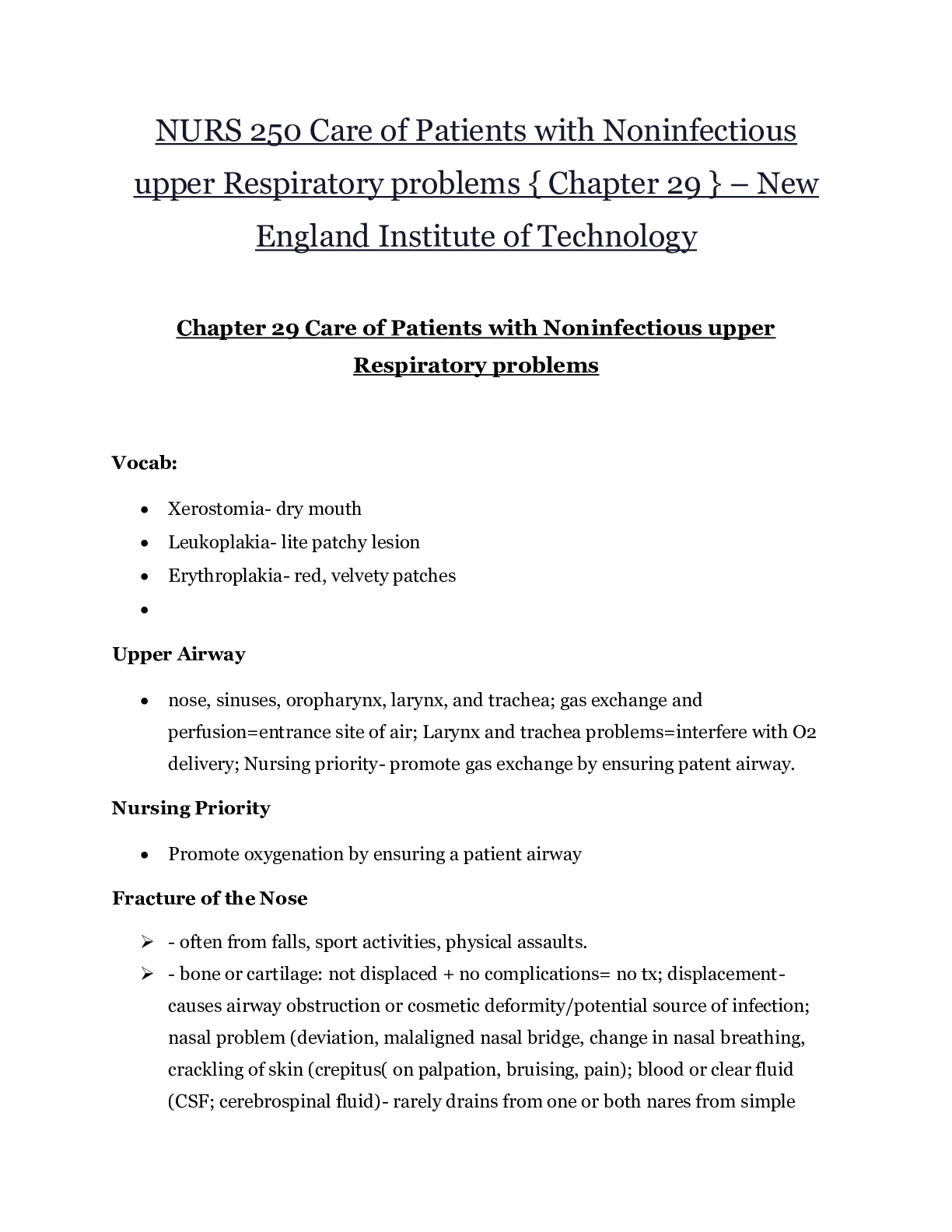
Buy this document to get the full access instantly
Instant Download Access after purchase
Add to cartInstant download
Reviews( 0 )
Document information
Connected school, study & course
About the document
Uploaded On
Jan 27, 2021
Number of pages
23
Written in
Additional information
This document has been written for:
Uploaded
Jan 27, 2021
Downloads
0
Views
35













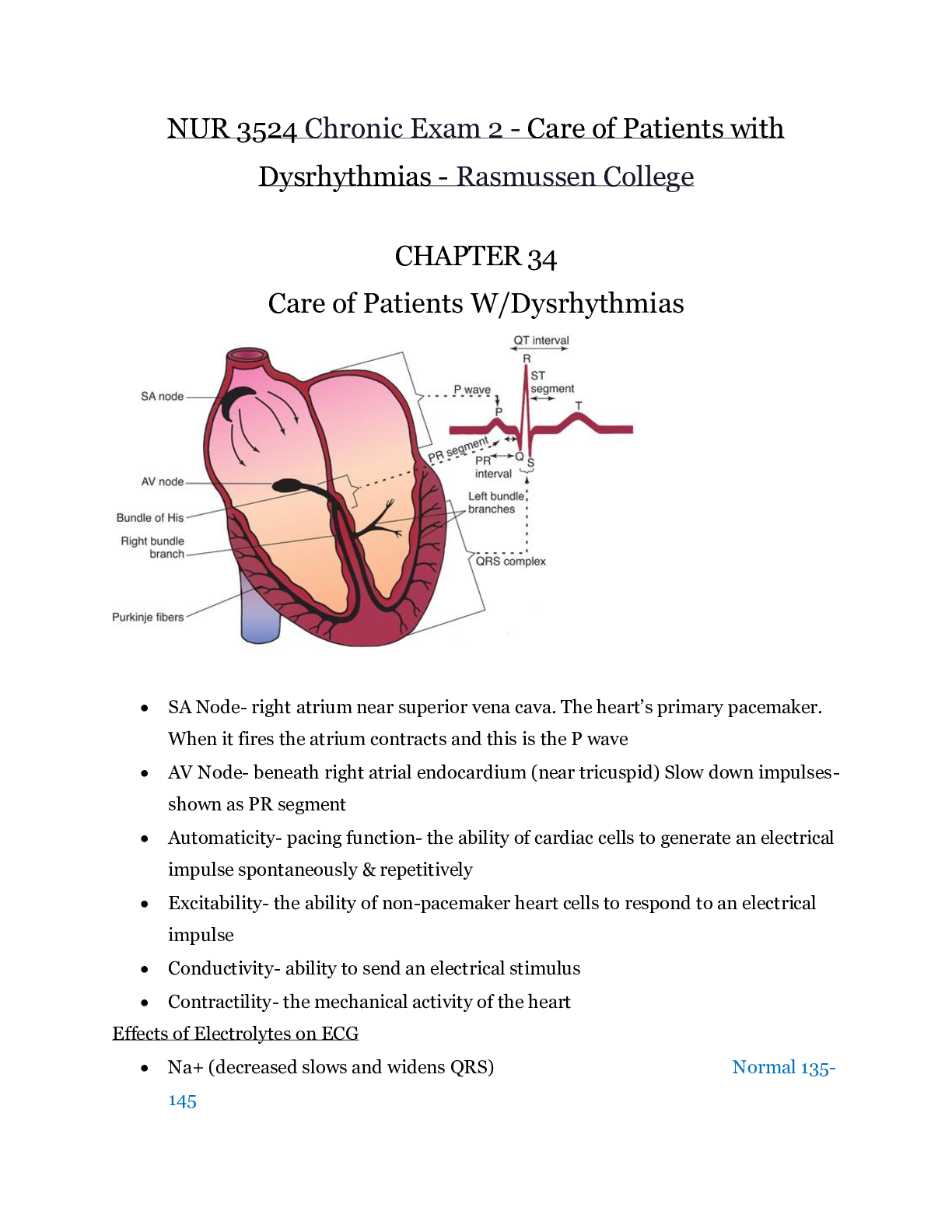


.png)
.png)
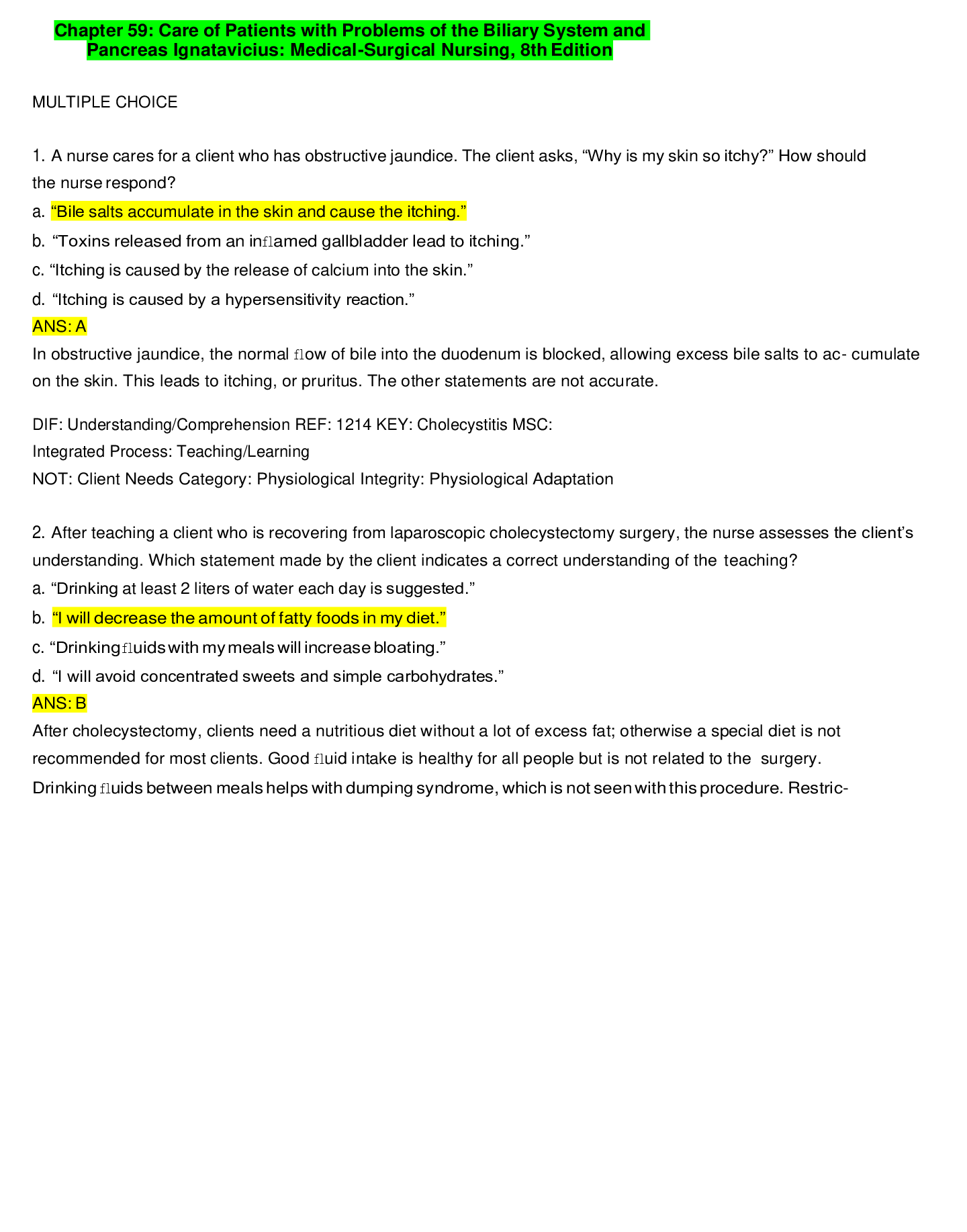
.png)
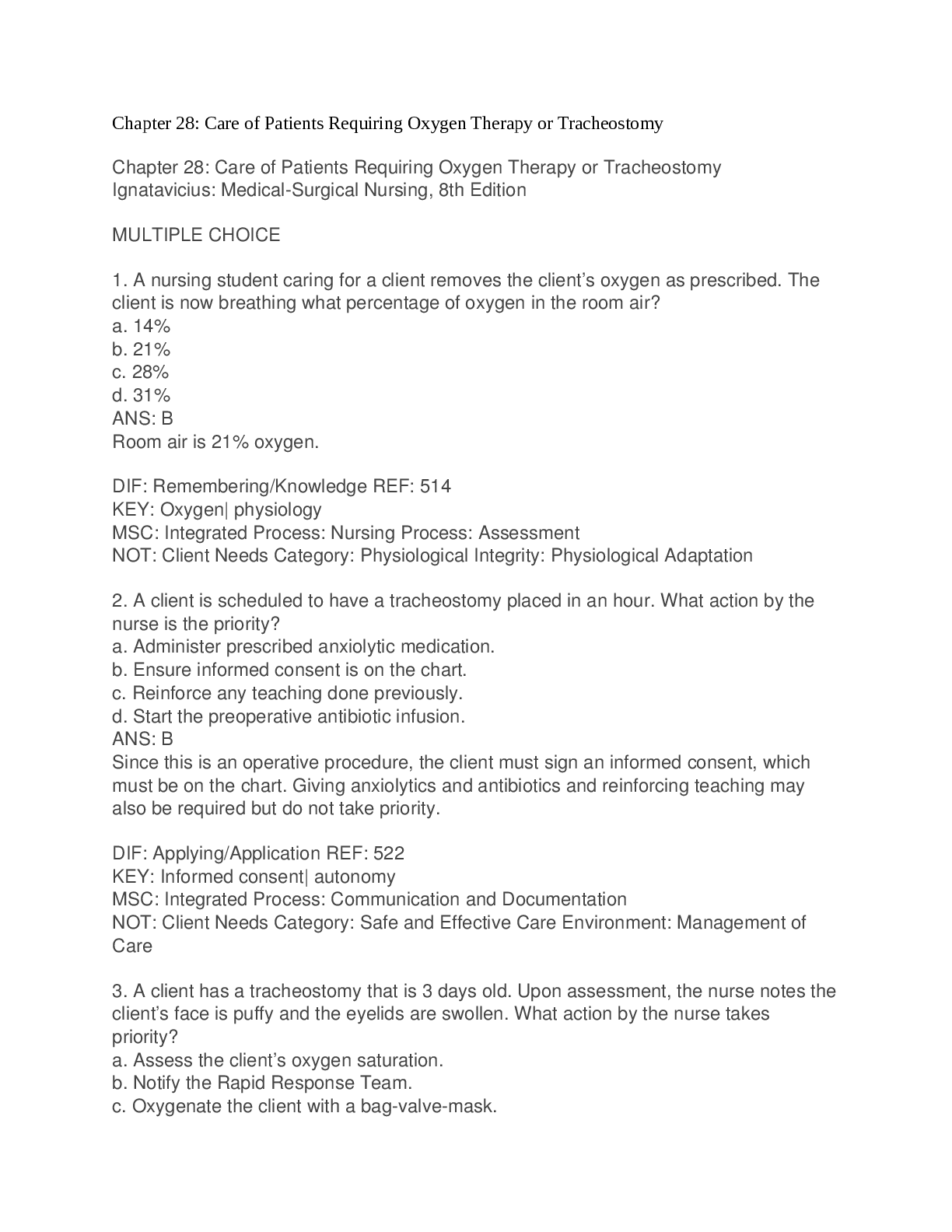
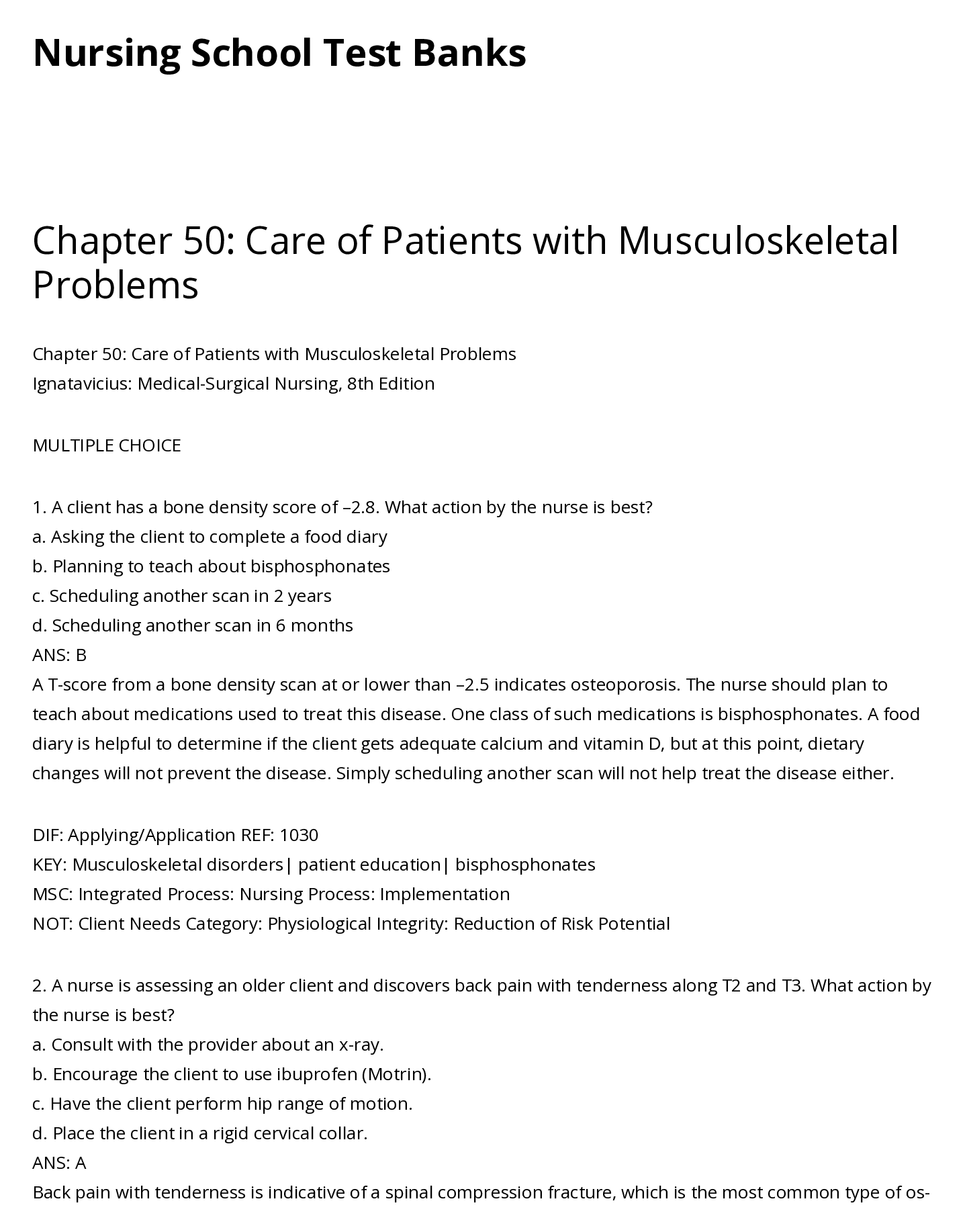
.png)

